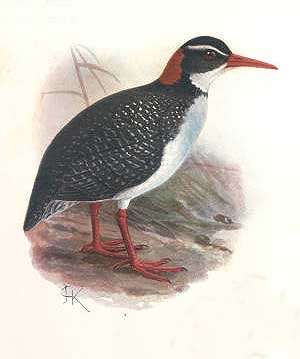|
| Query: Extinct birds | Result: 19th of 470 | |
Tahitian Red-billed Rail (Gallirallus pacificus) - Wiki
| Subject: | Tahitian Red-billed Rail (Gallirallus pacificus) - Wiki
| | Poster: | Administrator (kusnij@naver.com)
| |

| Resolution: 300x359
File Size: 13946 Bytes
Upload Date: 2008:04:06 18:43:30
|
Tahitian Red-billed Rail
From Wikipedia, the free encyclopedia
Order: Gruiformes
Family: Rallidae
Synonyms: Rallus pacificus, Hypotaenidia pacifica, Rallus ecaudatus
Status: Extinct (late 18th - 19th century)
[Photo] Tahiti Rail (Gallirallus pacificus) by John Gerrard Keulemans from 'Extinct Birds' by Lionel Walter Rothschild from the year 1907. Source: www.extinct.minks-lang.de/7voegel/voegel-bilder/gallirallus.pacificus.jpg
The Tahitian Red-billed Rail (Gallirallus pacificus) or Tahiti Rail is a poorly-known extinct species of rail. It once occurred on Tahiti, where, apparently on the second voyage of James Cook in 1773, one was acquired and described by Johann Reinhold Forster as well as painted by his son Georg. What became of Forster's specimen is not known. This flightless species was probably derived from the ubiquitous Buff-banded Rail stock. The Tahitian name was transcribed as ebōnā or ōmnā (see also below).
Due to a major taxonomic mix-up, the name Rallus ecaudatus was commonly used in the mid-late 20th century to refer to this bird. This is, however, in error, as that taxon is an extant subspecies of the Buff-banded Rail, today known as Gallirallus philippensis ecaudatus. Also, at least once, the Tahitian bird has been referred to by the scientific name of the Samoan Wood Rail, Gallinula pacifica, in a major scientific work.
Extinction
Little can be said about the species' disappearance. As with most extinct Pacific rails, introduced predators are the most likely suspects for its extinction. It may have become extinct soon after Cook's visit, but the bird was still reported to have existed until recently in 1844. Considering that the bird was probably very cryptic, this may have been true. Even more astounding is the claim by locals that it was found until approximately the 1920s on the islet of Mehetia, although this seems hardly true since the distance between Tahiti and Mehetia is about 100 km and the Red-billed Rail was, as mentioned above, flightless. The native name tevea seems to refer to the Mehetia bird. If indeed a rail existed on Mehetia, it is more probable that it was a closely related, but distinct species. Considering that Mehetia was not permanently inhabited and thus probably free from predators, it is even quite likely that the late extinction date of that bird is correct. Whether a distinct species could evolve and persist on tiny (2.3 km²) Mehetia is less certain, especially as the island seems to have been subject to heavy volcanic activity in the last 2000 years; an alternative explanation could be that birds were translocated from Tahiti by Polynesian woodcarvers for provisioning during their stays on Mehetia.
http://en.wikipedia.org/wiki/Tahitian_Red-billed_Rail
| The text in this page is based on the copyrighted Wikipedia article shown in above URL. It is used under the GNU Free Documentation License. You may redistribute it, verbatim or modified, providing that you comply with the terms of the GFDL. |
|
^o^
Animal Pictures Archive for smart phones
^o^
|
|